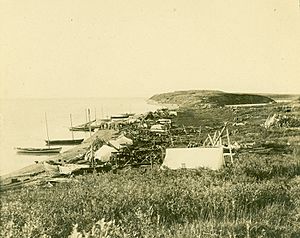Kitigaaryuit facts for kids
Kitigaaryuit (also spelled Kittigazuit) is a very old Inuvialuit settlement in Canada's Northwest Territories. It was the traditional home of the Kitigaaryungmiut group of Inuvialuit people. This important place is located near where the East Channel of the Mackenzie River meets Kugmallit Bay. It includes the villages of Kitigaaryuk and Tchenerark on a small island, and Kuugaatchiaq on the mainland nearby.
Contents
History of Kitigaaryuit
People have lived at Kitigaaryuit since at least the year 1400. In the summer, it was a super important spot for hunting beluga whales. It's said that the biggest gatherings of Inuvialuit, with up to 1000 people, happened here. The water in this area is very shallow, which made it a natural trap for belugas. Hunters would use kayaks and harpoons to catch them.
The number of people living in Kitigaaryuit changed with the seasons. Many Kitigaaryungmiut would leave in the autumn. They went to other places where hunting was better. In December, people would come back for special celebrations. But they would soon leave again, only to return for the next beluga hunt. In the summer, people lived in tents made from caribou skin. In winter, they lived in large wooden houses shared by several families. There were also big buildings called qadjgit or kajigi. These were used as meeting places for men and for special ceremonies.
Changes from Outside Contact
The Inuvialuit of the Mackenzie Delta had met foreign traders before. But their contact with people from Western societies grew a lot after 1889. That's when many American whalers started coming to the area. Starting in 1892, Christian missionaries, like Isaac Stringer, visited Kitigaaryuit. Stringer wrote down many details about the Kitigaaryungmiut culture. He also drew maps of the area.
In 1893, Stringer noted that Kitigaaryuit's population was 197. This was a big drop from earlier numbers. Sadly, diseases brought by outsiders were likely the main reason for this decline.
The Measles Epidemic
A serious measles outbreak happened in 1902. This caused the remaining people to leave Kitigaaryuk. The area was then empty for several years. An Inuvialuit elder once shared a story about this time:
It hadn't been long after the flu arrived that the people began to die off. People died in their tents. People died while they were working on the whales. [...] I remember there were so many people dying that they quit bothering to make graves. At times they would just put two or three bodies together and pile logs over them. It was a dreadful sight and a dreadful thing to think about at Kitigaaryuit, a place that had been so full of life and noise was now completely silent, for death was everywhere... People no longer went to Kitigaaryuit for there was fear of death all over the place.
People slowly returned to Kitigaaryuit. But by 1909, the population was only 103. Many of these new residents were Inupiat from Alaska, not Inuvialuit. The Hudson's Bay Company opened a trading post in Kitigaaryuk in 1912. It closed in 1933, and the area was abandoned after that. However, hunters still use the area seasonally today.
Archaeology at Kitigaaryuit
Archaeology is the study of human history through digging up old things. At Kitigaaryuk, you can find the remains of old Inuvialuit winter homes. There are also hundreds of traditional grave sites. In 1969, a team explored the area. They found what was left of the Hudson's Bay trading post. They also found an old log cabin and an ice house. Digging at the site has uncovered many beluga whale bones. These bones show how important beluga hunting was. In 1978, the Kittigazuit Archaeological Sites National Historic Site of Canada was created on the island. This helps protect the important history found there.


